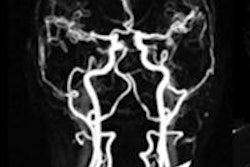
The prevalence of silent necrosis is around 12.3% and in most cases necrosis is of reduced extension, though systolic function tends to be worse in patients with necrosis, a major new Spanish study has found.
"Detection of silent necrosis is important in order to provide adequate therapy and improve prognosis," noted lead author Dr. Alicia Maceira, from the cardiac imaging unit at the ERESA Clinic in Valencia, Spain, in a presentation at the 2012 European Society of Cardiology (ESC) annual meeting in Munich. "Acute coronary syndromes may appear and develop in a silent way. These patients may not receive adequate therapy and thus are more prone to short- and long-term complications."
The objective of Maceira's group was to assess the prevalence of silent necrosis in a cohort of patients on whom a late gadolinium enhancement, cardiac MR exam was performed. The study included patients with no known previous history of acute coronary syndrome.
True fast imaging with steady-state precession (true FISP) cine sequences were used to measure left ventricular (LV) dimensions and ejection fraction, while short tau inversion-recovery (STIR) sequences were used to detect edema. In some patients, myocardial perfusion sequences also were used after intravenous dipyridamole (0.84 mg/kg). Inversion-recovery fast low-angle shot (IR-FLASH) sequences were used for late gadolinium enhancement. Images were analyzed by two independent observers.
At the ERESA Clinic, 1,342 patients were investigated (775 men, 62 ± 14 years). The referral to the clinic was to rule out coronary artery disease in 71.5% of cases and for the study of dilated cardiomyopathy in 12.4% of cases. The referral was to rule out myocarditis in 5.8% of cases and for the study of arrhythmogenic right ventricular cardiomyopathy in 3.7% of cases, as well as for valvular heart disease in 2.6% of patients. For the remaining 4%, the referral was due to other reasons.
Myocardial necrosis was detected in 165 of these patients (132 men, 66 ± 11 years). Those with silent necrosis were older and they were more frequently men, according to Maceira. About 20% of patients who were studied to rule out coronary artery disease and 12.4% of those studied for dilated cardiomyopathy had necrosis. None of the patients with suspected myocarditis had necrosis.
Necrosis extension was usually small: mean necrotic mass was 7.9 ± 9.4 g, percentage of necrotic myocardium was 4.2 ± 4.6%, and number of affected segments was 2.8 ± 2.1. In 17 patients (10.3%), the percentage of necrotic myocardium was greater than 10%, and in 20 patients (12%), the number of affected segments was more than five. After adjustment for age, gender, and reason for referral, patients with silent necrosis were shown to have worse systolic function (LV ejection fraction: 62 ± 1 versus 54 ± 3%, p < 0.01) and ventricular remodeling.



















